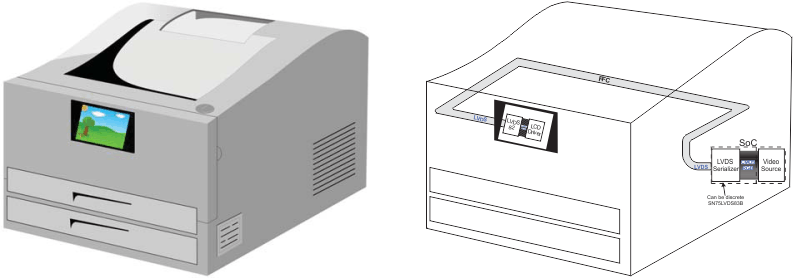SLLS259J November 1996 – October 2016 SN75LVDS82
PRODUCTION DATA.
- 1 Features
- 2 Applications
- 3 Description
- 4 Revision History
- 5 Description (continued)
- 6 Pin Configuration and Functions
- 7 Specifications
- 8 Parameter Measurement Information
- 9 Detailed Description
- 10Application and Implementation
- 11Power Supply Recommendations
- 12Layout
- 13Device and Documentation Support
- 14Mechanical, Packaging, and Orderable Information
Package Options
Mechanical Data (Package|Pins)
- DGG|56
Thermal pad, mechanical data (Package|Pins)
Orderable Information
1 Features
-
4:28 Data Channel Expansion at up to
1904 Mbps Throughput - Suited for SVGA, XGA, or SXGA Display
Data Transmission From Controller to
Display With Very Low EMI - Four Data Channels and Clock Low-Voltage
Differential Channels In and 28 Data and
Clock Low-Voltage TTL Channels Out - Operates From a Single 3.3-V Supply With
250 mW (Typical) - 5-V Tolerant SHTDN Input
- Falling Clock-Edge-Triggered Outputs
- Packaged in Thin Shrink Small-Outline
Package (TSSOP) With 20-Mil Terminal Pitch - Consumes Less Than 1 mW When Disabled
- Pixel Clock Frequency Range of 31 MHz to
68 MHz - No External Components Required for PLL
- Inputs Meet or Exceed the Requirements of
ANSI EIA/TIA-644 Standard
2 Applications
3 Description
The SN75LVDS82 FlatLink™ receiver contains four serial-in, 7-bit parallel-out shift registers, a 7× clock synthesizer, and five low-voltage differential signaling (LVDS) line receivers in a single integrated circuit.
These functions allow receipt of synchronous data from a compatible transmitter, such as the SN75LVDS83B, over five balanced-pair conductors, and expansion to 28 bits of single-ended low-voltage TTL (LVTTL) synchronous data at a lower transfer rate. The SN75LVDS82 can also be used with the SN75LVDS84 for 21-bit transfers.
When receiving, the high-speed LVDS data is received and loaded into registers at the rate of seven times (7×) the LVDS input clock (CLKIN). The data is then unloaded to a 28-bit-wide LVTTL parallel bus at the CLKIN rate. A phase-locked loop (PLL) clock synthesizer circuit generates a 7× clock for internal clocking and an output clock for the expanded data. The SN75LVDS82 presents valid data on the falling edge of the output clock (CLKOUT).
The SN75LVDS82 requires only five line-termination resistors for the differential inputs and little or no control. The data bus appears the same at the input to the transmitter and output of the receiver with the data transmission transparent to the user.
Device Information(1)
| PART NUMBER | PACKAGE | BODY SIZE (NOM) |
|---|---|---|
| SN75LVDS82 | TSSOP (56) | 14.00 mm × 6.10 mm |
- For all available packages, see the orderable addendum at the end of the data sheet.
Spacer
Spacer
